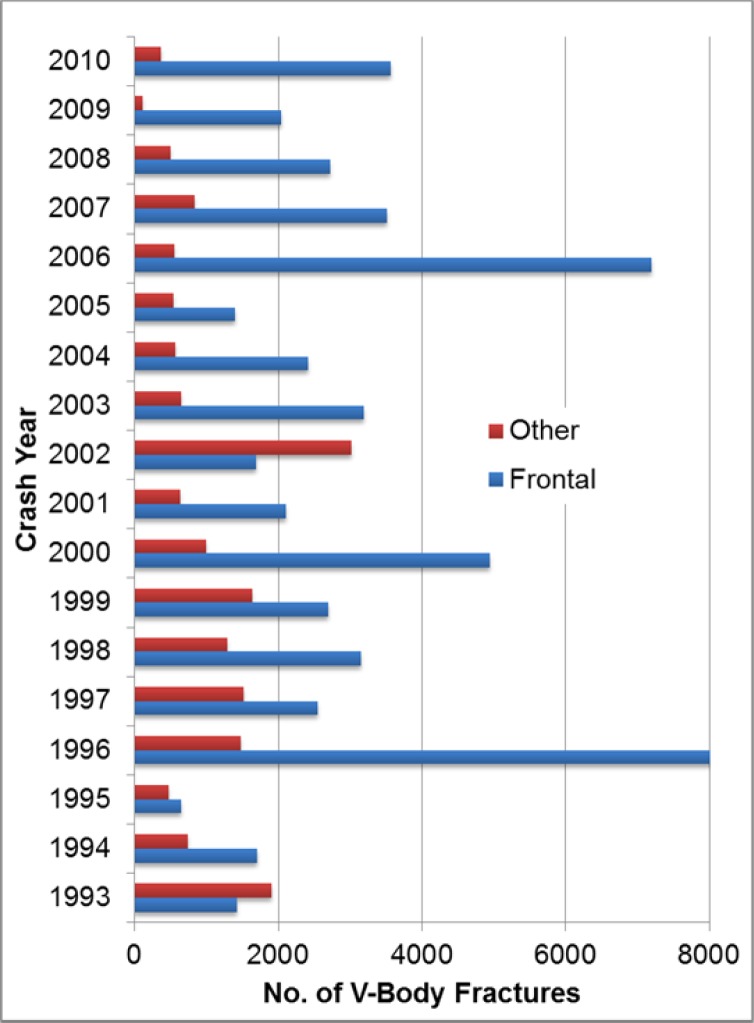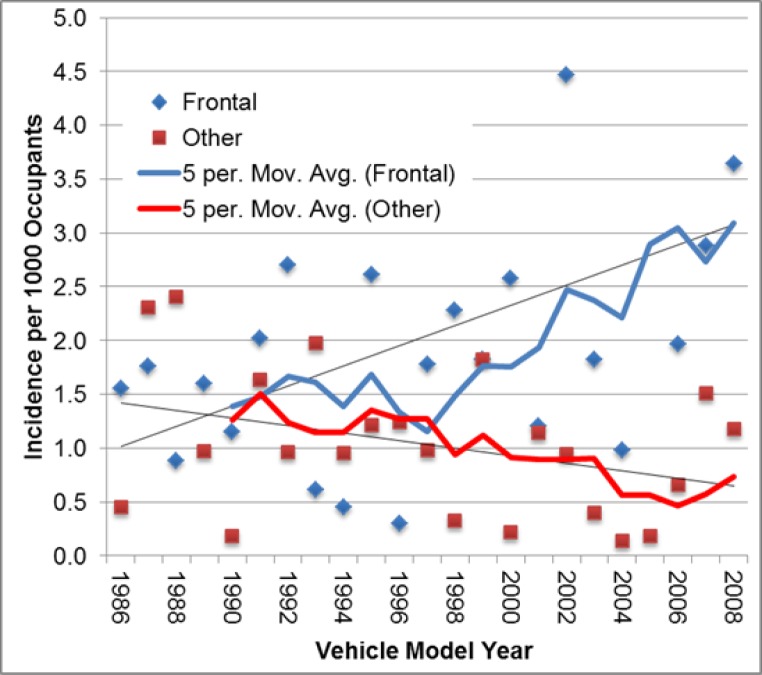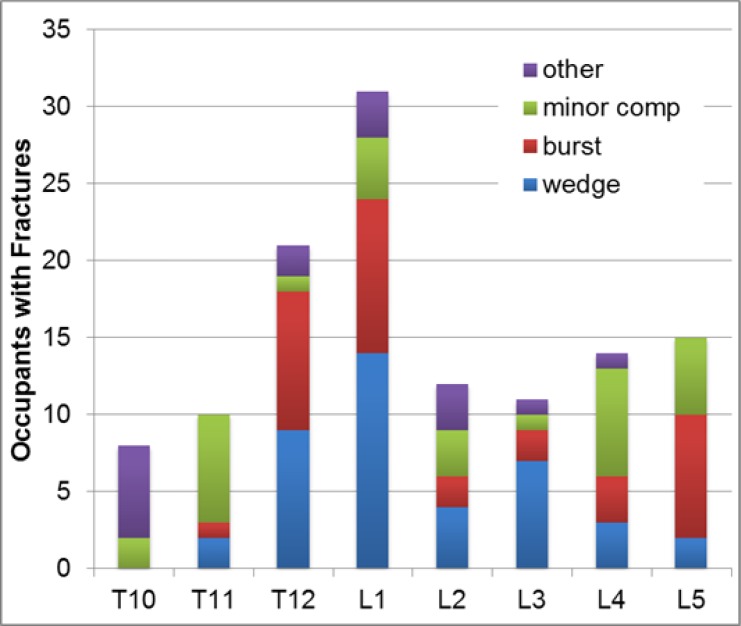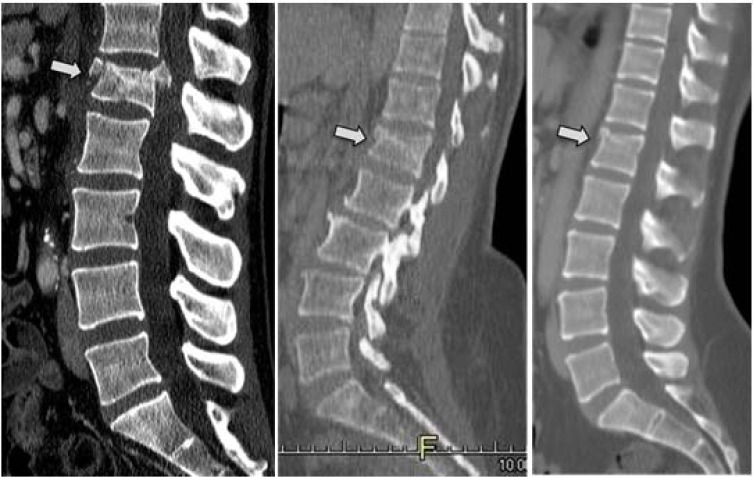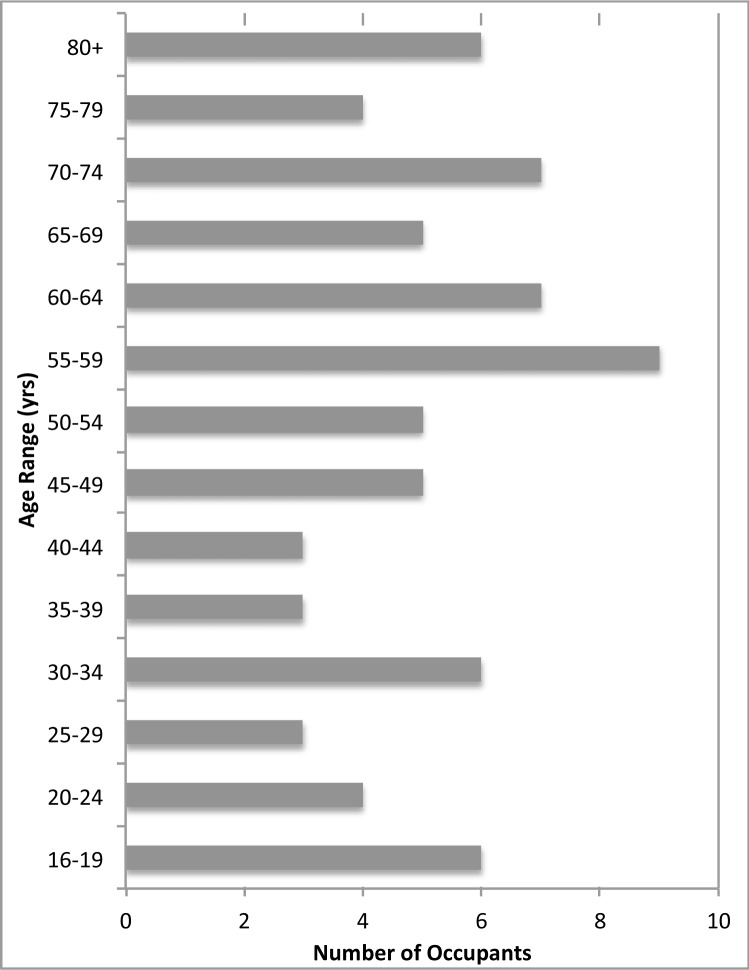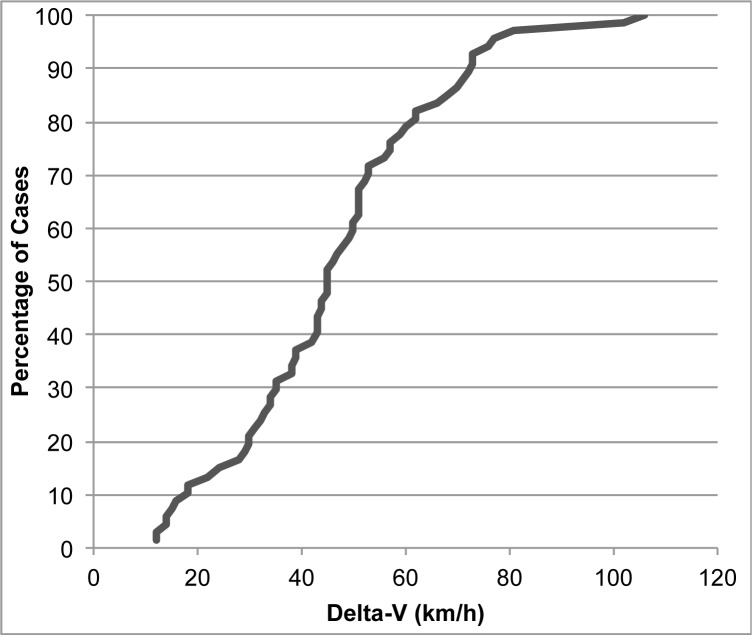Abstract
There is currently no injury assessment for thoracic or lumbar spine fractures in the motor vehicle crash standards throughout the world. Compression-related thoracolumbar fractures are occurring in frontal impacts and yet the mechanism of injury is poorly understood. The objective of this investigation was to characterize these injuries using real world crash data from the US-DOT-NHTSA NASS-CDS and CIREN databases. Thoracic and lumbar AIS vertebral body fracture codes were searched for in the two databases. The NASS database was used to characterize population trends as a function of crash year and vehicle model year. The CIREN database was used to examine a case series in more detail. From the NASS database there were 2000–4000 occupants in frontal impacts with thoracic and lumbar vertebral body fractures per crash year. There was an increasing trend in incidence rate of thoracolumbar fractures in frontal impact crashes as a function of vehicle model year from 1986 to 2008; this was not the case for other crash types. From the CIREN database, the thoracolumbar spine was most commonly fractured at either the T12 or L1 level. Major, burst type fractures occurred predominantly at T12, L1 or L5; wedge fractures were most common at L1. Most CIREN occupants were belted; there were slightly more females involved; they were almost all in bucket seats; impact location occurred approximately half the time on the road and half off the road. The type of object struck also seemed to have some influence on fractured spine level, suggesting that the crash deceleration pulse may be influential in the type of compression vector that migrates up the spinal column. Future biomechanical studies are required to define mechanistically how these fractures are influenced by these many factors.
INTRODUCTION
There is currently no injury assessment for thoracic or lumbar spine fractures in the motor vehicle crash standards throughout the world. Recent studies have indicated that spinal injury remains an issue in vehicular crashes [Bilston-2011, Wang-2009]. Older occupants (65-plus years) were found to be almost five times more likely to sustain spinal injury compared to younger occupants [Bilston, 2011]. The use of seatbelt and airbag was protective against cervical and thoracic fractures, but not for lumbar fractures [Wang-2009]. Also, the occurrence of spine fractures in vehicle crashes increased slightly from 1994–2002 even after adjustment for age, sex, seat belt and air bag use, type of vehicle, severity of damage, and location of crash [Wang-2009].
Others have also described thoracolumbar injuries in vehicle crashes emphasizing the mechanism of injury when the occupant interacts with the seat and/or restraint system [Ball-2000, Richards-2006, Munjin-2011, Inamasu-2007, Huelke-1995]. From a case series of vehicle crashes from the 1980’s and 1990’s, Huelke, et al postulated that three-point-belted occupants still sustained thoracolumbar fractures due to “submarining” of the occupant pelvis under the lap belt with a pre-flexed lumbar spine [Huelke-1995]. The earlier studies were concerned with the seat belt having a “fulcrum effect” on the spine, inducing spinal flexion around the belt. These fractures were described as mainly “flexion distraction” injuries with little or no vertebral body compression. In a more recent study that reported a case series of 37 motor vehicle crash patients, they found that 12 of 15 patients wearing a three-point belt restraint had thoracolumbar compressive burst fractures [Ball-2000]. They explained the burst fractures by hypothesizing that the thoracic spine will straighten “suddenly and forcibly” as the torso is held by the shoulder belt during the crash [Ball-2000]. In a more recent study that examined spine fractures in rear seat occupants of buses that traversed a speed bump, they found all the 44 cases had “compression” fractures due to a “catapult effect” of the occupant sitting rearward of the wheels. They described the occupant being elevated from the seat and then falling back down, but did not hypothesize as to which motion might have caused the fracture [Munjin-2011].
Reports from more recent model year vehicles and restraint systems describe types of thoracolumbar vertebral body fractures that have a compressive component of force that can occur with three-point restraint or with no belt restraint. However, none of the previously mentioned studies focused their efforts on the seat pan. Typical vehicle seat pans have an upward angle from rear to front that is often adjustable with modern electric controls, and many seat pans have anti-submarining structure that is designed to keep the occupant from submarining under the belt in a frontal impact. Compression-related thoracolumbar fractures are occurring in frontal impacts and yet the mechanism of injury is poorly understood. The objective of this investigation was to characterize these injuries using real world crash data. To investigate if these spine fractures may be affected by vehicle design changes, real world data was examined as a function of vehicle model year and seat type.
METHODS
Using the US Department of Transportation National Highway Traffic Safety Administration’s National Automotive Sampling System – Crashworthiness Data System (NASS-CDS) database, an initial study was conducted to determine the occurrence of thoracolumbar spine fractures and whether the incidence of thoracic or lumbar vertebral body fracture has changed as a function of vehicle model year. A search for AIS codes (same for 1998 and 2005 versions) for lumbar and thoracic vertebral body fractures [AAAM-1998] was conducted on the NASS-CDS samples from police-reported tow-away collisions from crash years 1993 to 2010 and separated into frontal impacts and all other type of impacts. Frontal impacts were defined as all crashes where the primary area of damage was “front”. All other types of impacts were defined where the primary area of damage was not frontal. The thoracic vertebral body fracture AIS codes searched were 650430.2 for fracture not further specified, 650432.2 for body fracture with less than or equal to 20% height loss, and 650434.3 for body fracture with greater than 20% height loss; similarly for the lumbar spine the codes searched were 650630.2, 650632.2, and 650634.3. The search included only front seat occupants 16 years of age or older; crashes with a rollover code either as primary or secondary were excluded. Occupants with at least one of the AIS codes were counted as a function of crash year and vehicle model year. Incidence of fracture occurrence was calculated by taking the weighted number of occupants with a thoracolumbar fracture divided by the total weighted occupant count for either vehicle model year or crash year. Occupant counts for the denominator included the same inclusion and exclusion criteria as used above except counted all occupants with and without injury. It is to be noted that beginning in crash year 2009 the NASS-CDS database has not logged occupant-related information for vehicles involved in crashes that were older than ten model years. The 2009 and later crash years were therefore excluded from the analysis of occupant counts by vehicle model year.
Using the US-DOT NHTSA Crash Injury Research and Engineering Network (CIREN) database, occupants with the AIS coded injuries as in the NASS-CDS study were searched in the database. Crashes were initially limited to frontal impacts only and those occupants where the fractured spine level was T10 or below. This was done to examine injury mechanisms thought to be related to seat pan and lap belt interaction with the pelvis. Spine levels above T10 could be related to a shoulder or thorax load and were excluded to simplify the analysis. Specifics of the crash scenario and additional details about the injuries were examined. Because the CIREN database has radiographic information from each patient, the type of fracture was also categorized into major (burst) or minor compression type where there was largely uniform compression of the vertebral body from posterior to anterior, wedge-type where the anterior was more compressed than the posterior, and other types that didn’t fit either category. Each crash scenario was also examined in more detail: whether the car departed the roadway, whether there was significant over-ride or under-ride during the crash, or if it was more of a typical planar frontal impact. Photos of each crashed vehicle were examined to determine if the frame rails (longitudinal) were engaged during the crash, and if the collision damage code (CDC) was sufficient to describe the crash.
RESULTS
From the NASS database there were approximately 2000–4000 occupants (weighted data) in frontal impacts with thoracic and lumbar vertebral body fractures per crash year (Figure-1). There were almost always (exception: 2002) less than 2000 occupants with fractures per year in all other crash types combined. However, as a function of vehicle crash year, there was a slightly increasing trend in incidence rate of thoracolumbar fractures in frontal impact crashes (linear regression trend line, P<0.02, model coefficient: 0.094; 95% Confidence Interval: 0.016 – 0.171) from 1986 to 2008; this was not the case for other crash types (Figure-2).
Figure 1:
NASS weighted data indicating the number of occupants with thoracolumbar vertebral body fractures by crash year, separated between frontal impacts and all other impacts.
Figure 2:
The incidence per 1000 occupants of thoracolumbar vertebral body fractures in occupants by vehicle model year using NASS weighted data, separated between frontal impacts and all other impact types. Linear trend lines are shown and five-point average lines are demonstrated.
From the CIREN database there were 204 frontal impact crash occupants found with thoracic and lumbar spine vertebral body fractures. Initially 122 occupants that had vertebral body fractures in spine levels at T10 or below were evaluated for fracture type (Figure-3). The thoracolumbar spine was most commonly fractured at either the T12 or L1 level. Major, burst type fractures occurred predominantly at T12, L1 or L5; wedge fractures were most common at L1 (Figure-4). Most of the major fractures (AIS codes with a ‘343’ on the end) occurred at T12 and L1 (Figure-5). To focus the analysis further on crash conditions that might lead to these types of fractures, crashes where a secondary rollover with more than two-quarter turns occurred after a frontal impact, occupants not in row one, occupants with previous thoracic and/or lumbar spine surgeries, and occupants reported in a sub-optimal posture pre-impact were excluded. This resulted in 73 cases to be examined in more detail.
Figure 3:
CIREN data demonstrating fractures types by level in 122 cases evaluated.
Figure 4:
Examples of fracture types found in the CIREN database. Left is a burst fracture of L1; center is a wedge fracture of L1; right is a minor compression fracture of L1.
Figure 5:
CIREN data indicating number of occupants with major or minor vertebral body fractures by spine level for 122 cases. Major and minor is defined by AIS code >20% or <20% height loss.
Occupants with thoracolumbar vertebral body fractures in the 73 CIREN cases were characterized as follows. The age of the 73 occupants did not seem to be biased in any particular age group although occupants from 50–64 years of age had the highest numbers compared to other age groups (Figure-6). Frontal crashes can be characterized in severity by change of velocity (Delta-V) calculated by physics-based crash analysis software. Most of the 73 cases (six missing) had either a Delta-V calculation or a Barrier Equivalent Speed (BES) estimate. If the Delta-V was present, it was used; if Delta-V was not present and BES was present, it was used as a Delta-V substitute. Ranking the crashes by crash severity, 73% of the crashes occurred at a Delta-V of 56 km/h or less (Figure-7).
Figure 6:
Analysis of 73 CIREN cases indicating number of occupants in the age range shown.
Figure 7:
Analysis of 73 CIREN cases indicating percentage of cases by delta-V. Note that at least 70% of the cases were at delta-v below NCAP speed of 56 km/h.
Referring to Table-1 below, most occupants were belted; there were slightly more females involved; they were almost all in bucket seats; and impact location occurred approximately half the time on the road and half off the road. A predominant number (55 out of 73) of occupants were in late-model year vehicles 2000–2010. Examining crash details it was determined that engagement of both longitudinal structural rails of the vehicle was fairly rare with 37 crashes that engaged one rail and 25 that did not engage either rail.
Table-1.
Characteristics of 73 CIREN occupants with thoracolumbar vertebral body fractures involved in frontal impacts.
| Restraint Status | Belted | 66 |
| Not Belted | 7 | |
| Gender | Males | 33 |
| Females | 40 | |
| Object Struck | Fixed hard object | 10 |
| Ground | 4 | |
| SUV/Van | 9 | |
| Tree/pole | 30 | |
| Pass. car / mini-Van | 13 | |
| Tractor-trailer/truck | 7 | |
| Over/Under-Ride | Present | 7 |
| Not Present | 66 | |
| Longitudinal Rails Engaged | 0-Rails | 25 |
| 1-Rail | 37 | |
| 2-Rails | 11 | |
| Seat type | Bucket Seat | 64 |
| Non-bucket seat | 9 | |
| Crash Type | Planar | 48 |
| Compatibility Issue | 12 | |
| Non-horizontal | 10 | |
| Oblique | 3 | |
| Impact Location | Off Road | 38 |
| On Road | 35 | |
| Vehicle Model Year | 1990–94 | 4 |
| 1995–99 | 13 | |
| 2000–04 | 35 | |
| 2005–10 | 20 |
An over-ride or under-ride scenario was also uncommon, occurring only seven times out of the 73 cases. Non-horizontal impacts such as entering a ditch or climbing an embankment occurred only ten out of 73 cases. Most impacts were considered planar and 12 of 73 occurred with an incompatible vehicle type. It is interesting that many (44) were single vehicle crashes with 30 out of 73 impacts having occurred with a tree or pole.
To determine additional information regarding fracture mechanisms, the spine level of fracture was examined with respect to other factors. Since 30 of 73 occupants had fractures at spine levels T12 or L1, cases where alternate spine levels were fractured were evaluated. With respect to occupant age, occupants from 16–29 had fractures at levels other than T12-L1 85% of the time, whereas 55% of occupants aged 30–59, and 52% of occupants 60 or greater had fractures at other levels. There was also a bias with gender where 24/33 (73%) males had fractures at non-T12-L1 levels, whereas 19/40 (48%) of females had fractures at levels other than T12 or L1. The object struck may also have some bearing on what spine level the fracture occurs. Of the ten occupants that had T10 or T11 fractures, five of them occurred with a tractor-trailer or heavy truck. Of the ten impacts with a fixed hard object, eight of them produced L1 fractures. Of the 30 tree/pole impacts, 17 produced fractures at L2 or below.
DISCUSSION
This study summarized the occurrence of vertebral body fractures in the thoracic and lumbar spine that occur in vehicle crashes. It was determined that these fractures occur predominantly in frontal impacts. The question was asked as to what the mechanism and nature of this injury is during this type of crash scenario. Using both the US DOT NHTSA NASS-CDS database and the CIREN database, these types of injuries were examined and characterized. While the NASS-CDS database offers a weighted population-based sample where incidence rates and trends may be obtained, it is sometimes hard to infer injury mechanisms from this database. The CIREN database captures far more detailed data on only injured vehicle occupants wherein injury mechanisms are documented and coded. CIREN is not intended to infer population trends. CIREN has become a sentinel for injurious mechanisms either not expected, measured or well understood. In this context, the combined results from both databases allow a framework for further research – be they biomechanical, epidemiological, or investigational.
In characterizing the incidence of these fractures, it was found that there is an increasing trend in these fractures as a function of model year. Other studies have not examined vehicle model year as a variable in the incidence of thoracolumbar fractures. Another paper that examined all types of fractures of the thoracic and lumbar spine concluded that spine fractures were relatively rare and occurred mainly at very high crash speeds [Richards, 2006]. They reported incidents rates from 1.2 – 20 per 1000, for delta-Vs under 60 km/h, which is similar to the present study although the present analysis is focused only on vertebral body fractures. Acknowledging that the actual incidence of these fractures is low, an increasing trend by vehicle model year is disturbing as the vehicle fleet changes. Perhaps because information is lacking on lumbar spine injury, the present vehicle regulatory tests do not measure thoracolumbar spine loads in the test dummy and therefore manufacturers’ design changes may allow for increasing loads to be transmitted to the spine through the seat pan or restraint system. This may be even more prevalent as smaller vehicles with less crush space enter the market.
Although the NASS database does not allow for detailed analysis as to spine level injured and fracture types, the CIREN database was evaluated for a case series examining the same type of AIS fracture codes that were evaluated for the NASS study. The predominant fracture types were wedge and burst fractures with T12 and L1 being the most common injured spine levels. This agrees with other studies reporting on fractured levels for compression-related mechanisms of fracture [Munjin, 2011]. The accepted rationale for these spine levels being predominant is that this is the transition region of the thoracolumbar spine where the curvature changes from kyphosis to lordosis, and somehow this curvature change makes the region more vulnerable [Munjin, 2011]. The present analysis also examined other variables in the crash scenarios such as gender: these fractured levels were less common in males. The type of object hit also seemed to have some influence on fractured spine level although, admittedly, the sample size for this case series was too small to arrive at robust conclusions. Hypothesizing that the object struck will have an influence over the crash deceleration pulse, it may be influential in the type of compression vector that migrates up the spinal column. In other words, the crash pulse will dictate how the occupant interacts with the seat pan, which in turn dictates how load may be transmitted up the spine.
When examining the scenarios surrounding each crash in the CIREN case series, it was surprising that not more of the cases had obvious non-horizontal components. A burst or wedge fracture of the thoracic or lumbar spine vertebral body occurs largely under a compression force. This implies that, for occupants involved in frontal crashes, there is some vertical component of force that is applied to the pelvis through the vehicle seat pan. This has caused CIREN crash investigators to begin conducting a more thorough inspection of the vehicle seat pan to look for signs of loading and/or deformation. During some of the scenarios that were investigated with the details found in the CIREN database, there was an obvious vertical component in the crash, such as the corner of the vehicle impacting an angled roadside barrier. Many others however, were direct planar frontal impacts, implying that the seat pan itself may be sufficient to provide enough of a compressive component to the distal spine.
There were relatively few cases with over-ride or under-ride, and most were considered “planar”. More than half of the crashes occurred off the road, but this was because many were single vehicle crashes into a tree. Most of these were still considered planar impacts. With the increased incidence of this fracture in modern vehicles, there may be seat pan design changes, like the anti-submarining bar, that are commonly used to control frontal dummy kinematics in standardized frontal crash tests, that may be contributing to the increased incidence of these fractures. These changes and smaller vehicles with stiffer crash pulses may also adversely affect the occurrence of these spine fractures. Future biomechanical studies are required to define mechanistically how these fractures are influenced by these many factors.
CONCLUSION
A study using both the US-DOT-NHTSA NASS-CDS and CIREN databases was conducted to learn more about thoracolumbar spine fractures in vehicle collisions. There was a significantly increasing trend in incidence of thoracic and lumbar vertebral body fractures as a function of vehicle model year. Major, burst type fractures occurred predominantly at T12, L1 or L5; wedge fractures were most common at L1. The type of object struck also seemed to have some influence on fractured spine level, suggesting that the crash deceleration pulse may be influential in the type of compression vector that migrates up the spinal column.
Acknowledgments
This research was supported in part by US DOT NHTSA CIREN research funds DTNH22-10-H-00292 and by the Department of Veterans Affairs Medical Research. The views expressed are those of the authors and do not represent those of the funding agency. We gratefully acknowledge the assistance of Dale Halloway, James Rinaldi, Greg Stadter, and Sheena Smiddy of the Wisconsin CIREN project team.
REFERENCES
- Association for the Advancement of Automotive Medicine . The Abbreviated Injury Scale, 1990 Revision Update 98. Des Plaines, IL: 1998. [Google Scholar]
- Ball ST, Vaccaro AV, Albert TJ, Cotler JM. Injuries of the Thoracolumbar Spine Associated with Restraint Use in Head-On Motor Vehicle Accidents. Journal of Spinal Disorders. 2000;13(4):297–304. doi: 10.1097/00002517-200008000-00005. [DOI] [PubMed] [Google Scholar]
- Begeman PC, King AI, Prasad P. Spinal Loads Resulting from -Gx Accelerations. STAPP. 1973 Paper No. 730977, [Google Scholar]
- Bilston LE, Clarke EC, Brown J. Spinal Injury in Car Crashes: Crash Factors and the Effects of Occupant Age. Injury Prevention. 2011;17:228–232. doi: 10.1136/ip.2010.028324. [DOI] [PubMed] [Google Scholar]
- Dogan S, Safavi-Abbasi S, Theodore N, Chang SW, Horn EM, Mariwalla NR, Rekate HL, Sonntag VKH. Thoracolumbar and Sacral Spinal Injuries in Children and Adolescents: A Review of 89 Cases. Journal of Neurosurgery. 2007;106:426–433. doi: 10.3171/ped.2007.106.6.426. [DOI] [PubMed] [Google Scholar]
- Huelke DF, Mackey MG, Morris A. Vertebral Column Injuries and Lap-Shoulder Belts. Journal of Trauma: Injury, Infection, and Critical Care. 1995;38(4):547–566. doi: 10.1097/00005373-199504000-00014. [DOI] [PubMed] [Google Scholar]
- Inamasu J, Guiot BH. Thoracolumbar Junction Injuries After Motor Vehicle Collision: Are There Differences in Restrained and Nonrestrained Front Seat Occupants. Journal of Neurosurgery Spine. 2007;7:311–314. doi: 10.3171/SPI-07/09/311. [DOI] [PubMed] [Google Scholar]
- Munjin MA, Zamorano JJ, Marre B, Ilabaca F, Ballesteros V, Martinez C, Yurac R, Urzua A, Lecaros M, Fleiderman J, Garcia N. Speed Hump Spine Fractures: Injury Mechanism and Case Series. Journal of Spinal Disorders and Techniques. 2011;24:386–389. doi: 10.1097/BSD.0b013e3182019dda. [DOI] [PubMed] [Google Scholar]
- Neumann P, Nordwall A, Osvalder AL. Traumatic Instability of the Lumbar Spine: A Dynamic In Vitro Study of Flexion-Distraction Injury. Spine. 1995;20(10):1111–1121. doi: 10.1097/00007632-199505150-00001. [DOI] [PubMed] [Google Scholar]
- Ragel BT, Allred CD, Brevard S, Davis RT, Frank EH. Fractures of the Thoracolumbar Spine Sustained by Soldiers in Vehicles Attacked by Improvised Explosive Devices. Spine. 2009;34(22):2400–2405. doi: 10.1097/BRS.0b013e3181b7e585. [DOI] [PubMed] [Google Scholar]
- Richards D, Carhart M, Rassch C, Pierce J, Steffey D, Ostarello A. Incidence of Thoracic and Lumbar Spine Injuries for Restrained Occupants in Frontal Collisions. Association for the Advancement of Automotive Medicine; 50th Annual Proceedings; October 16–18, 2006; [PMC free article] [PubMed] [Google Scholar]
- Wang MC, Pintar FA, Yoganandan Y, Maiman DJ. The Continued Burden of Spine Fractures After Motor Vehicle Crashes. Journal of Neurosurgery Spine. 2009;10:86–92. doi: 10.3171/SPI.2008.10.08279. [DOI] [PubMed] [Google Scholar]



